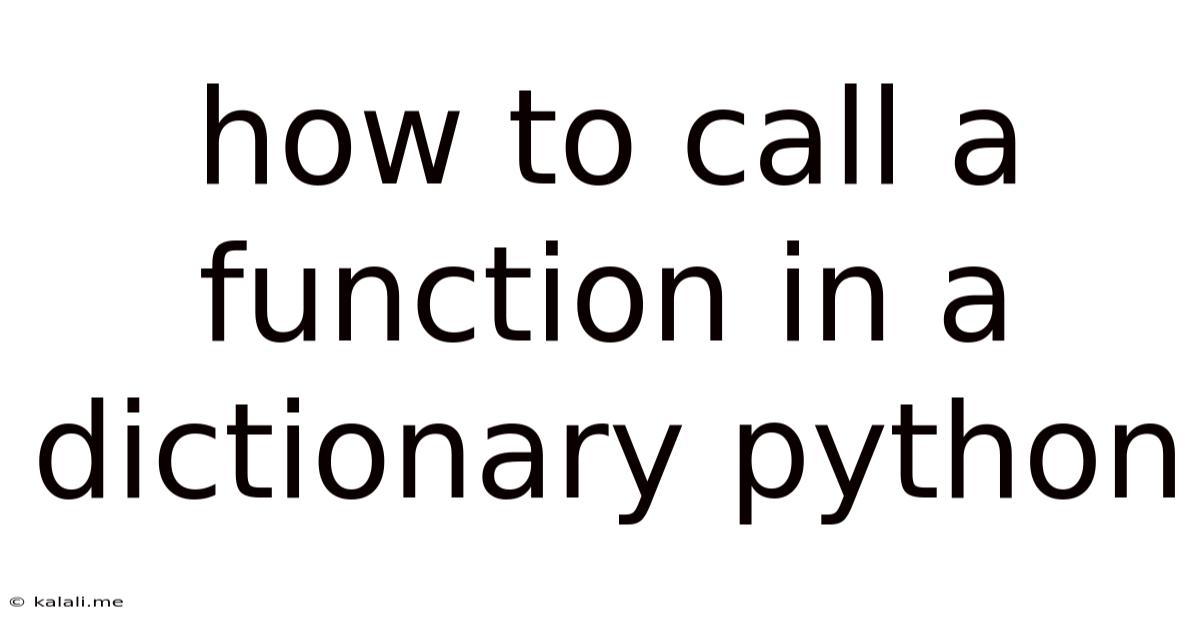How To Call A Function In A Dictionary Python
Kalali
Jun 10, 2025 · 3 min read

Table of Contents
How to Call a Function Stored in a Python Dictionary
This article explores various methods to call functions stored as values within a Python dictionary. Understanding this technique is crucial for building flexible and dynamic programs, allowing you to manage and execute different functions based on specific conditions or user input. We'll cover different approaches, best practices, and common pitfalls to avoid.
Storing functions within dictionaries offers a powerful way to organize and access your code. Imagine needing to perform different operations based on user choices – a dictionary mapping user inputs to corresponding functions provides an elegant solution. This technique is particularly useful in scenarios like command-line interfaces, game development, or any application requiring conditional function execution.
Method 1: Direct Function Call
The simplest method involves directly calling the function stored as a value in your dictionary. This approach is straightforward but requires knowing the exact function name beforehand.
def function_a():
print("This is function A")
def function_b():
print("This is function B")
my_dict = {
"action_a": function_a,
"action_b": function_b
}
# Call functions directly
my_dict # Output: This is function A
my_dict # Output: This is function B
This method is efficient and easy to understand, especially for simpler applications. However, it lacks flexibility if you need to determine the function to call dynamically.
Method 2: Using a Variable to Store the Function Key
For more dynamic scenarios, you can store the function key in a variable. This enables you to select the function to execute based on user input or program logic.
def function_a():
print("This is function A")
def function_b():
print("This is function B")
my_dict = {
"action_a": function_a,
"action_b": function_b
}
user_input = input("Enter action (action_a or action_b): ")
if user_input in my_dict:
my_dict
else:
print("Invalid action.")
This improved approach allows for conditional function calls, making your program more adaptable. Error handling, like the if statement, is essential to prevent KeyError exceptions if the user inputs an invalid key.
Method 3: Handling Potential Errors with try-except Blocks
To enhance robustness, incorporate a try-except block to gracefully handle cases where the key might not exist in the dictionary.
def function_a():
print("This is function A")
def function_b():
print("This is function B")
my_dict = {
"action_a": function_a,
"action_b": function_b
}
user_input = input("Enter action (action_a or action_b): ")
try:
my_dict
except KeyError:
print("Invalid action selected. Please choose from the available options.")
except Exception as e:
print(f"An unexpected error occurred: {e}")
This method prevents program crashes due to unexpected input. The addition of a general Exception catch improves error handling by capturing unforeseen issues during function execution.
Best Practices and Considerations
- Clear Function Naming: Use descriptive function names to improve code readability and maintainability.
- Modular Design: Organize your functions into separate modules to improve code organization.
- Error Handling: Always include error handling (using
try-exceptblocks) to prevent unexpected program termination. - Documentation: Document your functions and dictionary structure clearly using docstrings. This is essential for collaboration and future maintenance.
- Input Validation: Before calling a function, validate user input to ensure it's within the expected range or format.
By employing these techniques and best practices, you can effectively use dictionaries to manage and call functions in your Python programs, creating more dynamic and robust applications. Remember to choose the approach that best suits your specific needs and complexity of your project.
Latest Posts
Latest Posts
-
How Long Would It Take To Drive 2000 Miles
Jul 01, 2025
-
What Color Does Black And Blue Make
Jul 01, 2025
-
How To Pass Level 7 In Bloxorz
Jul 01, 2025
-
How Much Years Is 1 Billion Minutes
Jul 01, 2025
-
I Reject Your Reality And I Substitute My Own
Jul 01, 2025
Related Post
Thank you for visiting our website which covers about How To Call A Function In A Dictionary Python . We hope the information provided has been useful to you. Feel free to contact us if you have any questions or need further assistance. See you next time and don't miss to bookmark.